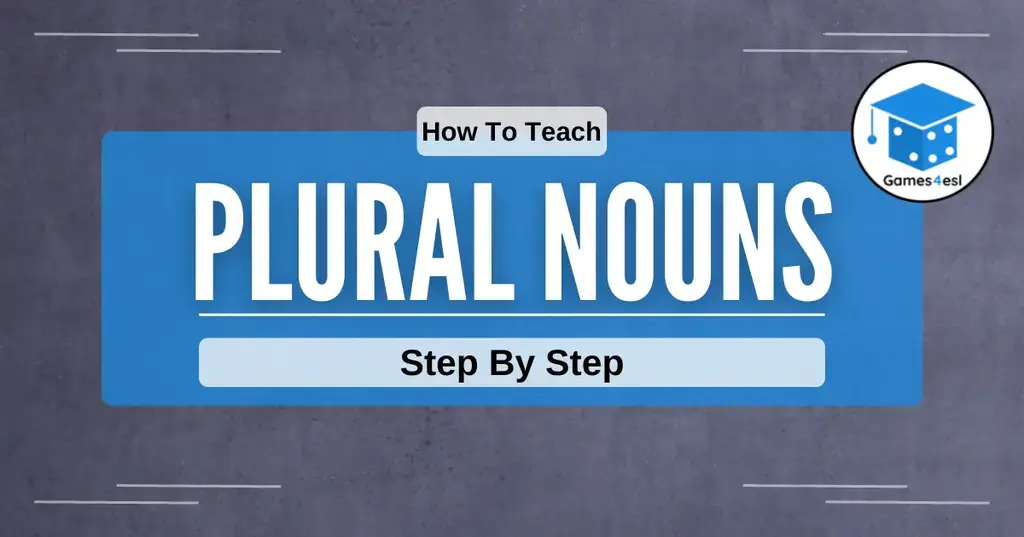

How To Teach Plural Nouns | A Step By Step Guide
Teaching English plural nouns can be challenging! Not only are there several rules for forming plural nouns, there are also many irregular nouns that don’t follow these rules. This makes mastering plural nouns a rather tricky task for English language learners. In this guide, we will detail step by step how to teach plural nouns in a fun and effective way so that your students can understand and use plural nouns in no time! Let’s get started.
How To Teach Plural Nouns
Step 1: introduce plural nouns in context.
Before students can learn how to form plural nouns, they first need to understand the concept of plurals. When teaching new concepts or grammar points to students, it’s always best to explain them in context. A great way to do this with plural nouns is to draw a simple building on the board and tell students it is your fruit and vegetable store.
Write the singular and plural forms of each of the fruit/vegetables on the board and practice saying them chorally as a class. For example, “ one apple, two apples. “, “ one cherry, two cherries “, etc. Once students have practiced enough and understand the concept of plurals, it’s time to show students how to form plural nouns.
Step 2: Introduce The Plural Noun Rules
| Rule | Which Nouns? | Examples |
|---|---|---|
| add | regular nouns | , apple , pencil |
| add | nouns ending in -s, -ss, -sh, -ch, -x, -z | , lunch , tax |
| add | nouns ending in -y and the letter before -y is a consonant | , pupp , cherr |
Step 3: Practice Forming Plural Nouns
As there are a few different ways to form plural nouns, students will need lots of practice. A great way to have students practice is to provide them with a list of nouns and have them change them into the plural form based on the rules table you have drawn on the board. If students are young or low-level, you may want to put students in pairs or small teams to do this.
Step 4: Play A Plural Nouns Game

Step 5: Introduce Irregular Plural Nouns
Once students have had lots of practice with regular plural nouns, it’s important to let them know that some nouns are irregular and so do not follow the regular plural noun rules. To learn irregular plural nouns, students just have to memorize the words. Here is a list of some common irregular plural nouns:
Step 6: Make Sentences With Plural Nouns
Related resources.
Plural Nouns: English Language
This document provides rules for forming plurals in English. It lists common singular and plural noun pairs and explains how to make nouns plural by adding "s", "es", or other suffixes depending on whether the singular form ends in a consonant or vowel. There are also notes on irregular plurals and nouns that stay the same in both singular and plural form. Exceptions to the standard rules are highlighted. Read less
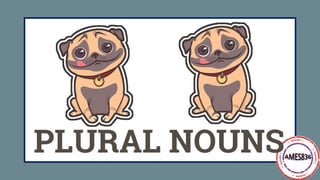
Recommended
More related content, what's hot, what's hot ( 20 ), more from a. simoes, more from a. simoes ( 20 ), recently uploaded, recently uploaded ( 20 ).
- 1. PLURAL NOUNS
- 2. Singular (one) Plural (more than one) one dog one watch one mouse two dogs three watches three mice
- 3. Add “s” Singular Plural one dog two dogs one door two doors
- 4. Add “-s” Singular Plural one cap two caps one chair two chairs
- 5. Singular Plural “-S”, “-SS”,”-CH”, ”-SH”,”-X” bus dress brush buses dresses brushes Add “-es”
- 6. Singular Plural watch fox watches foxes sandwich sandwiches Add “-es”
- 7. Singular Plural baby babies Consonant + Y butterfly butterflies Add “-ies”
- 8. Singular Plural strawberry strawberries ferry ferries Consonant + Y Add “-ies”
- 9. Singular Plural toy toys monkey monkeys Vowel + Y Add “-s”
- 10. Singular Plural key keys boy boys Vowel + Y Add “-s”
- 11. Singular Plural kangaroo kangaroos hippo hippos “-o” Add “-s”
- 12. Exceptions: Singular Plural flamingo flamingoes tomato tomatoes Add “-es”
- 13. Exceptions: Singular Plural potato potatoes hero heroes Add “-es”
- 14. Exceptions: Singular Plural mango zero mangos zeros Add “-s” or “-es”
- 15. Exceptions: Singular Plural mango mangoes zero zeroes Add “-s” or “-es”
- 16. Singular Plural knife knives “-fe” Add “-ves” life lives
- 17. Singular Plural loaf loaves “-f” leaf leaves Add “-ves”
- 18. Exceptions: Singular Plural chef chefs roof roofs Add “-s”
- 19. Singular Plural man woman person men women people Irregular
- 20. child tooth foot children teeth feet mouse mice Singular Plural Irregular
- 21. Singular Plural reindeer reindeer fish fish The same
- 22. Singular Plural sheep sheep salmon salmon The same
- 23. Singular Plural pants pants scissors scissors Always plural
- 24. Singular Plural sandals sandals binoculars binoculars Always plural
- 25. Designed by Patricss / Freepik.com Designed by rosapuchalt/ Freepik.com Designed by macrovector/ Freepik.com Designed by @freepik/ Freepik.com Designed by brgfx/ Freepik.com
- 26. Designed by Patricss / Freepik.com Designed by rosapuchalt/ Freepik.com Designed by macrovector/ Freepik.com Designed by microvector/ Freepik.com Designed by brgfx/ Freepik.com
plural nouns
myahvargas2630
Created on May 12, 2021
More creations to inspire you
Blended learning.
Presentation
INTRO INNOVATE
Summer zine 2018, fall zine 2018, international events, master's thesis english, 49ers gold rush presentation.
Discover more incredible creations here
Plural nouns
Most singular nouns are made plural by simply putting an -s at the end. There are many different rules regarding pluralization depending on what letter a noun ends in. Irregular nouns do not follow plural noun rules, so they must be memorized or looked up in the dictionary.
examples: wharf- wharves wolf-wolves sheaf- sheaves
examples:buttress-buttressesblotch-blotchesbleach-bleaches
examples:house-houses cat-cats girl-girls
If the noun ends with ‑f or ‑fe, the f is often changed to ‑ve before adding the -s to form the plural version.
If the singular noun ends in ‑s, -ss, -sh, -ch, -x, or -z, add ‑es to the end to make it plural.
To make regular nouns plural, add ‑s to the end.
example: birthday- birthdays
example: berry- berries
If the singular noun ends in -y and the letter before the -y is a vowel, simply add an -s to make it plural.
If a singular noun ends in ‑y and the letter before the -y is a consonant, change the ending to ‑ies to make the noun plural.
example: expo-expos
example: volcano- volcanoes
Ends in consonat + o add - es
Ends in vowel + O add- s
Irregular nouns follow no specific rules, so it’s best to memorize these or look up the proper pluralization in the dictionary. child – children goose – geese man – men woman – women tooth – teeth foot – feet mouse – mice person – people
Plural Noun Rules for Irregular Nouns

Powerpoint: Plural Nouns
A powerpoint on plural nouns ready to be used with animations and transitions for a lesson. Introduce to students the basic spelling concepts of plurals.
Useful Links
You might also like, about mr. greg.
Mr. Greg is an English teacher from Edinburgh, Scotland, currently based in Hong Kong. He has over 5 years teaching experience and recently completed his PGCE at the University of Essex Online. In 2013, he graduated from Edinburgh Napier University with a BEng(Hons) in Computing, with a focus on social media.
ESL Activities
ESL Games, Activities, Lesson Plans, Jobs & More
in Icebreakers + Warm-Ups · Listening · Reading · Speaking
Singular and Plural Noun Activities, Worksheets & Lesson Plans
Do you want some fresh, new ideas for singular and plural nouns? Then you’ll definitely want to check out these plural noun games and singular noun activities, along with worksheets, lesson plans, online practice resources and more.
Activities and games for singular and plural nouns
ESL Singular and Plural Noun Activities and Games
Without further ado, let’s get into the best singular plural nouns games and activities that you can try out with your English learners today.
Please enable JavaScript
#1: Plural Nouns Crossword
One of the best activities for plural nouns is to make up a crossword puzzle. My go-to resource is Discovery.com’s Puzzlemaker . Use the singular noun for the clues but the plural noun in the answers. Yes, it really is that easy!
#2: Concentration ESL Memory Game
If you’re teaching absolute beginners about singular and plural nouns for the first time, then you may want to consider trying out concentration. The way it works is that you make matching cards with the singular and then the plural version of the same word.
In groups of 4, students mix them up and place them face down on the desk. Then, they take turns picking two cards to see if they match. Find out how to set it up and play this ESL memory game here:
Concentration ESL Game .
#3: Dictogloss Singular and Plural Noun Game
If you want to challenge the listening skills of your students, then consider trying out Dictogloss. Besides listening, you can choose to focus on either speaking or writing.
The way it works is that you find (or write) a passage filled with the target vocabulary. In this case, it might have lots of plural nouns for example. Then, put students into pairs and read it out at a faster than normal pace. Students take notes on what they’ve heard and try to recreate it by either speaking or writing. Read it again and students add to what they have. Finally, they can compare their version with the original.
Do you want to try it out with your students? Find out all the details you need to know here: Dictogloss .
- Amazon Kindle Edition
- Bolen, Jackie (Author)
- English (Publication Language)
- 110 Pages - 06/05/2020 (Publication Date)
#4: Flashcard Sentences
If you teach beginners, then consider bringing some flashcards to class with you. In my opinion, they are one of the most under-utilized teaching resources out there! In this case, have a mix of singular nouns and plural nouns. Then, show each student a card and they have to make a sentence.
That’s just one very simple example, but there are lots of other games you could consider too. Here are some of my favourites: ESL Flashcard Games .
#5: Singular and Plural Noun Videos
Sometimes I get the feeling that my students are tired of hearing me talk! Is that the case for you? Yes? Well, then you might consider using some videos in your class instead of lecturing all the time. In this case, there are a ton of excellent videos to teach singular plural nouns. Have a look on YouTube for so many good ones to choose from.
#6: Proof-Reading and Editing
It’s often not until students see something in writing, or have to write it themselves that they get a grasp on it. In this case, one activity I like to use to reinforce key grammatical concepts is proofreading.
For beginners, make a passage or dialogue filled with errors that are related to a certain topic. In this case, the errors would be related to plural or singular nouns. More advanced students can often handle a wider variety of errors, from spelling to grammar and punctuation.
Students have to correct the passage and I usually tell them how many mistakes they can expect to find. Do you want to give it a try with your English learners? Find out more here: ESL Proofreading Activity .
#7: Picture Prompt ESL Warmer
One easy, fun way to introduce singular and plural nouns is to use a picture filled with lots of interesting things. Then, elicit from the students what they see. They may say dog. If there’s more than one dog, ask how many. The students may say two dog. Then, you could correct them and say two dogs?
See where I’m going with this? It’s kind of the ultimate way to introduce plural nouns to beginners. More recommendations here:
ESL Picture Prompt Activity .
- 85 Pages - 02/02/2020 (Publication Date)
#8: Clothing + Plural and Singular Nouns
The clothes unit is definitely one that lends itself well to singular and plural. For example, we always say pair of pants, instead of pant. Or, a glove vs. gloves.
For some of the best ideas on how to teach about clothing, you’ll want to take a look at the following resource: ESL Clothing Activities and Games.
#9: Singular and Plural Nouns Songs
If you teach kids, consider incorporating some songs and chants into your lesson. Not great at singing? Don’t worry about it. There are a million and one resources on YouTube for just about any topic or grammar point, including plural nouns.
#10: Whiteboard Games and Activities
I’m not sure why, but students seem to love writing on the whiteboard! Take advantage of this because there are a ton of fun relay type ESL games that you can play. And, many of them work very well with teaching plural nouns. One simple game is to say the singular noun of something and students have to race to write the correct plural form.
There are way more ideas here: ESL Whiteboard Games .
#11: Is that Sentence Correct?
I love to use this simple warm-up activity in the next class after I’ve taught singular and plural nouns. The way it works is that you write some sentences on the whiteboard. Some are correct while others are not. Students have to choose the incorrect ones and then fix them.
More details about this error correction activity here: Is that Sentence Correct?
#12: Brochure Scanning
A quick reading activity that you can use to introduce plural and singular nouns is brochure scanning. Find a brochure or menu of some kind. Then, have students quickly scan through it and make a list of 5-10 (depends on the length of the brochure) singular nouns and then the same amount of plural nouns.
Find out more details here: ESL Scanning Activity .
#13: Hot Potato
Try out hot potato, a fun singular and plural noun game with your students:
#14: Quantifiers and Singular/Plural Nouns
Quantifiers like some, any, much, many are a natural fit with singular and plural nouns and they’re in fact often taught together in many ESL textbooks. If you want some of the best ideas for teaching about quantifiers, then you’ll want to check this out:
ESL Quantifier Activities
#15: Countable and Uncountable Noun Activities
Singular and plural nouns are closely related to countable and uncountable nouns. For example, uncountable nouns like pollution or air will never be made plural.
For some of the best ideas for these kinds of nouns, you’ll want to take a look at this:
ESL Countable and Uncountable Nouns .
#16: Body Parts and Singular/Plural Nouns
Body parts is another one of those topics that is often combined with plural and singular nouns. Things like legs, fingers, toes, etc. lend themselves very well to making plurals.
Do you want to see some of our top ideas for this unit? Then you’ll want to check out the following:
ESL Body Part Activities and Games .
#17: ESL Conversation Lesson
It’s easy to plan an English convo lesson about just about anything, including singular/plural nouns. Follow these simple steps:
#18: The Memory Circle
A fun memory game to help your students out with plural nouns is this memory circle game. Give students a topic. Animals for example. Then, the first student makes a sentence using a plural noun: I have 2 dogs.
The next student has to say that first sentence and then add their own. He has 2 dogs and there are 6 elephants at the zoo. The game continues on until someone can’t remember something. They are out and the game continues on until the last person is left standing. I recommend that the teacher take notes about the additions unless you have a freakishly good memory!
#19: ESL Vocabulary Auction
Although this ESL vocabulary and sentence-building game does require a bit of prep, I find that it’s totally worth it. In this case, you’d want to make some sentences with both plural and singular nouns. Then, cut up the sentences into words and students have to bid on words that they think can help them form the maximum amount of sentences. After that, there’s some trading time with other teams.
Finally, students make sentences and the team who can make the most is the winner. Do you want to try it out? See more details here: ESL Vocabulary Auction .
#20: Dialogue Substitution
#21: eliciting singular and plural noun activity.
Unless you’re teaching absolute beginners, it’s likely that your students already know a fair amount about how to make singular nouns plural. If this is the case, I like to elicit some information from my students about how to do this.
Doing this serves two purposes. The first is that it’s easy to see what my students already know and also where their knowledge gaps are so that I can target my lesson more appropriately to that. Secondly, it helps to activate the students’ prior knowledge so that it’s easier for them to retain the new information. Find out how to do it here:
How to Elicit Language from English Learners .
#22: Dictation, a Singular and Plural Nouns Activity
Dictation has kind of fallen out of favour these days as the more communicative style of teaching is all the rage. However, it can still be quite a valuable exercise.
In this case, say a sentence that has either singular or plural nouns or both. Students have to write down what they hear, using correct punctuation and spelling. Check the answers together with the class.
#23: Running Dictation
Check out this singular and plural noun game for all ages.
#24: There Is/There Are Activities
There is and there are, along with singular and plural nouns. They are like 4 peas in a pod and can’t really be separated! Have a look here at some of my top ideas for practicing them:
There Is/There Are ESL Activity Ideas .
#25: Find the Plural
Give students a worksheet or handout with sentences that contain singular nouns. Instruct them to identify the singular noun in each sentence and then rewrite the sentence using the corresponding plural noun. This activity reinforces the concept of changing nouns from singular to plural in context.
#26: Noun Hunt
Have students search for examples of singular and plural nouns in authentic texts such as newspapers, magazines, or books. They can underline or highlight the nouns they find and create a list of singular and plural pairs. Afterwards, they can discuss their findings and share their lists with the class.
#27: Plural Puppet Show
Divide students into small groups and provide them with craft materials to create puppets. Each group selects a singular noun and creates a puppet representing that noun. They then develop a short skit or dialogue in which the singular noun becomes plural. Encourage students to use the plural form of the noun correctly in their puppet shows.
#28: Board Game
Create a board game where students move around the board by correctly identifying singular and plural nouns. Each time a student lands on a space, they must say the plural form of a given singular noun or vice versa. Use colorful visuals and provide clear instructions to make the game enjoyable and educational.
#29: Online Quizzes and Interactive Games
Utilize online resources such as ESL websites or apps that offer interactive quizzes and games specifically designed to teach singular and plural nouns. These activities can provide additional reinforcement and practice in an engaging digital format.
#30: Singular or Plural Toss
Create two baskets or containers labeled “Singular” and “Plural.” Prepare a collection of noun cards, each with a singular or plural noun written on it. Students take turns selecting a card and deciding whether it is a singular or plural noun. They must then toss the card into the corresponding basket. Discuss and correct any incorrect choices.

#31: Collective Nouns
Collective nouns can be a little bit tricky for students. Have a look at this list:
Collective noun list .
Did you Like these Plural Activities for ESL?
- 87 Pages - 10/24/2019 (Publication Date)
Yes? Thought so. Then you’re going to love this book over on Amazon: 39 No-Prep/Low-Prep ESL Grammar Activities and Games . The key to better English class is a wide variety of interesting and engaging games and activities and this book will help you do that in style.
You can get these ESL grammar activities book in both digital and print formats. Keep a copy on the bookshelf in your office and use it as a handy reference guide when making your lesson plans. Or, take the digital copy with you on your phone to your favourite coffee shop for some serious lesson planning on the go.
Yes, it really is that easy! Check out the book for yourself on Amazon, but only if you want a serious dose of ESL teaching awesome in your life:
Singular and Plural Nouns ESL Lesson Plans
Are you a busy teacher who doesn’t have time to always plan lessons? Then we have some good news for you! There are a ton of excellent singular and plural lesson plans that you can just print off and use. Here are some of the best resources out there:
TEFL Handbook
Education.com
Plural and Singular Worksheets
Why reinvent the wheel if you don’t have to, right? The better idea is to borrow some ideas from teachers who’ve gone before you. In this case, there are lots of great worksheets to help your students practice plural nouns and singular nouns. Here are some of our top picks:
ISL Collective
All Things Grammar
Busy Teacher
Online Practice for Plural and Singular Nouns
If your students need a little bit more practice with plural and singular, then you may want to recommend some of the following online practice resources:
My English Pages
Roy the Zebra
Singular and Plural Nouns Activities
Singular and Plural Noun FAQS
There are a number of common questions that people have about these kinds of nouns. Here are the answers to some of the most popular ones.
What is a singular and plural noun?
A singular noun is one person, place, thing or idea. A plural noun is more than one of these things. There are a few specific rules to remember to make singular nouns plural.
How do you teach singular nouns to plural?
Here are a few hints to teach students how to make singular nouns into their plural form:
- The spelling of the singular nouns will be your guide as to how to form the plural.
- Add s/es to the end of most singular nouns to make them plural.
- There are some exceptions (foot—>feet, mice—>mouse, half—>halves).
- Some nouns the same for both singular and plural (deer).
How to teach singular plural nouns ESL?
To teach singular and plural nouns to ESL students, first show them the forms and rules for making plurals, along with a few exceptions. Then, use a variety of interactive and student-centred ESL games and activities for students to get some practice, including running dictation, dictogloss, videos, reading and listening passages, concentration, flashcard games, and more.
How do you make a noun plural?
In English, most nouns become plural by adding “-s” or “-es” to the singular form. For example, “cat” becomes “cats,” and “box” becomes “boxes.”
Are there any irregular plural nouns?
Yes, there are some irregular plural nouns that do not follow the typical “-s” or “-es” rule. Examples include “child” (children), “man” (men), and “mouse” (mice).
What are some common mistakes learners make when using plural nouns?
Some common mistakes include forgetting to add “-s” or “-es” to make a noun plural, or adding “-s” to a noun that is already plural, like saying “childs” instead of “children.”
How can I help my students understand th concept of singular and plural nouns?
Engage students in hands-on activities, use visual aids, and provide plenty of examples. Encourage practice through speaking, writing, and interactive exercises.
Have your say about these Singular and Plural Activities
What’s your top pick for activities to teach singular and plural nouns? Is it one of them from this list or do you have another that you’d like to recommend? Leave a comment below and let us know what you think. We’d love to hear from you.
Also be sure to give this article a share on Facebook, Pinterest, or Twitter. It’ll help other busy English teachers, like yourself find this useful teaching resource.
Last update on 2022-07-17 / Affiliate links / Images from Amazon Product Advertising API
About Jackie
Jackie Bolen has been teaching English for more than 15 years to students in South Korea and Canada. She's taught all ages, levels and kinds of TEFL classes. She holds an MA degree, along with the Celta and Delta English teaching certifications.
Jackie is the author of more than 60 books for English teachers and English learners, including Business English Vocabulary Builder and 39 No-Prep/Low-Prep ESL Speaking Activities for Teenagers and Adults . She loves to share her ESL games, activities, teaching tips, and more with other teachers throughout the world.
You can find her on social media at: YouTube Facebook Pinterest TikTok LinkedIn Instagram
Top Selling ESL Activity Book
As an Amazon Associate, I earn from qualifying purchases.
More ESL Activities and Games
Esl books for adults: english conversation, business, writing, winter clothes names with pictures | list of winter clothing, musical instruments names with pictures: top 25, teach past tense: esl activities, games, lesson plans & more, about, contact, privacy policy.
Best-selling author and English teacher Jackie Bolen has been talking ESL activities and games since 2015. The goal is to bring you the best ideas, lesson plans, and activity recommendations for your TEFL classes.
Get in touch: About + Contact
Privacy Policy and Terms of Use
Email: [email protected]
Address: 2436 Kelly Ave, Port Coquitlam, Canada
Spelling and Pronunciation Rules for Plural Nouns: Regular Plural Nouns
- Heather Marie Kosur
- Categories : Esl lesson plans for all grade levels
- Tags : Teaching english as a second language
English Nouns
A noun is a word that names a person, place, thing, or idea. Prototypical English nouns show number through singular and plural forms. Singular nouns reference one person, place, thing, or idea while plural nouns reference two or more people, places, things, or ideas. Regular nouns in English take either the suffix -s or the suffix -es attached to the singular form in the plural. The following sections explain and exemplify the spelling and pronunciation rules for forming the plurals of regular nouns in English.
Regular Plural Nouns
The plural morphological suffix for most English nouns is simply -s , which is added to the end of the singular form. For example, the following chart identifies the singular and plural forms of some common regular English nouns:
Singular – Plural
- apple – apples
- brother – brothers
- elbow – elbows
- holiday – holidays
- kite – kites
- notebook – notebooks
- zebra – zebras
However, if the singular form of the noun ends with s(e) or c(e) [s], z(e) [z], sh [š], ch [č], or dg(e) [ĵ], then the plural morphological suffix is -es . For example, the following chart identifies the singular and plural forms of some common regular English nouns ending in s(e) or c(e) [s], z(e) [z], sh [š], ch [č], or dg(e) [ĵ]:
- ash – ashes
- box – boxes
- church – churches
- English – Englishes
- judge – judges
- kiss – kisses
- language – languages
- watch – watches
If the singular form of the noun ends with a consonant followed by a y , then the y changes to an i and is followed by the plural morphological suffix is -es . For example, the following chart identifies the singular and plural forms of some common regular English nouns ending in a consonant followed by a y :
- authority – authorities
- body – bodies
- cherry – cherries
- family – families
- history – histories
- memory – memories
- panty – panties
- story – stories
If the singular form of the noun ends with f or fe , then the f or fe changes to a ve and is followed by the plural morphological suffix is -s . For example, the following chart identifies the singular and plural forms of some common regular English nouns ending in f or fe :
- calf – calves
- knife – knives
- leaf – leaves
- life – lives
- self – selves
- thief – thieves
- wife – wives
- wolf – wolves
The f or fe to ve rule does not apply if the verb form of the noun ends in ve as in belief-beliefs (noun) and believe-believes (verb).
Nouns Ending in -o
The plural morphological suffix for English nouns ending in -o is either -s or -es , which is added to the end of the singular form, depending on the specific noun. If the singular form of the noun ends with an o preceded by another vowel or vowel sound, then the plural morphological suffix is -s . For example, the following chart identifies the singular and plural forms of some common English nouns ending in an o preceded by a vowel or vowel sound:
- bamboo – bamboos
- cameo – cameos
- embryo – embryos
- radio – radios
- scenario – scenarios
- stereo – stereos
- studio – studios
If the singular form of the noun ends in o and the word is of foreign origin including most musical terms, then the plural morphological suffix is also -s . For example, the following chart identifies the singular and plural forms of some common English nouns of foreign origin ending in an o :
- alto – altos
- canto – cantos
- kimono – kimonos
- photo – photos
- piano – pianos
- rondo – rondos
- solo – solos
- taco – tacos
If the singular form of the noun ends with an o preceded by a consonant, then the plural morphological suffix is -es . For example, the following chart identifies the singular and plural forms of some common English nouns ending in an o preceded by a consonant:
- domino – dominoes
- echo – echoes
- embargo – embargoes
- hero – heroes
- mosquito – mosquitoes
- potato – potatoes
- tomato – tomatoes
- veto – vetoes
For some nouns ending in an o preceded by a consonant, however, the plural morphological suffix is either -s or -es . For example, the following chart identifies the singular and plural forms of some common English nouns that take either the -s or the -es suffix:
- avocado – avocados/avocados
- buffalo – buffalos/buffaloes
- desperado – desperados/desperadoes
- ghetto – ghettos/ghettoes
- halo – halos/haloes
- hobo – hobos/hoboes
- portico – porticos/porticoes
- tornado – tornados/tornadoes
The current trend for spelling the plurals of nouns ending in o preceded by a consonant seems to be moving in the direction of adding only the morphological suffix -s , particularly in the case of nouns with variable spellings.
Pronouncing Regular Plurals
Although the plural morphological suffix for regular English nouns is -s or -es , the suffix is pronounced differently depending on the sound of the last syllable of the noun. If the last syllable of the noun sounds like:
- s, se, ce [s]*
- j, dge [ĵ],
then the suffix is pronounced as a voiced ez [әz]. For example:
- ashes [ӕšәz]
- boxes [boksәz]
- churches [čәrčәz]
- faces [fesәz]
- grudges [grәĵәz]
- marshes [maršәz]
If the last syllable of the noun is a voiceless sound, then the suffix is pronounced as an unvoiced s [s]. Voiceless sounds are produced by not vibrating the larynx in the throat. The voiceless, or unvoiced, sounds in English are:
- t, tt, te [t]
- k, ck, ke [k]
For example:
- beliefs [bilifs]
- cakes [keks]
- drinks [driŋks]
- fruits [fruts]
- laughs [lӕfs]
- units [junɪts]
If the last syllable of the noun is a voiced sound, then the suffix is pronounced as a voiced z [z]. Voiced sounds are produced by vibrating the larynx in the throat. The voiced sounds in English are:
- l, ll, le [l]
All vowels in English are also voiced sounds. For example:
- bombs [bamz]
- boys [boijz]
- halves [hӕvz]
- moans [monz]
- songs [saŋz]
- tries [traijz]
*The letters in brackets are the sounds written in the International Phonetic Alphabet preceded by some spellings of the sounds in written English.
Printable Download
For a printable reference study sheet of the morphological, spelling, and pronunciation rules for forming plurals of regular nouns in English, please download the supplement to this article Forming Plural Nouns in English: Rules for Plural Nouns Reference Sheet .
This post is part of the series: How to Form Plural Nouns in English
The following two part series lists the morphological, spelling, and pronunciation rules for forming the plurals of regular and irregular nouns in English. Part one explains the rules for regular English nouns. Part two explains the rules for irregular English nouns.
- Forming Plurals of Regular Nouns in English: Morphological, Spelling, and Pronunciation Changes
- Forming Plurals of Irregular Nouns in English: Morphological, Spelling, and Pronunciation Changes

Singular and Plural Nouns
Nov 15, 2014
1.17k likes | 2.37k Views
Singular and Plural Nouns. Notes On Generalizations For Spelling/Forming Plural Nouns. Singular vs. Plural. A singular noun names one person, place, thing, or idea. One cat, one store, one item A plural noun names two or more persons, places, things, or ideas.
Share Presentation
- plural nouns
- singular nouns
- compound nouns
- word compound nouns
- plural nouns formed correctly

Presentation Transcript
Singular and Plural Nouns Notes On Generalizations For Spelling/Forming Plural Nouns.
Singular vs. Plural • A singular noun names one person, place, thing, or idea. • One cat, one store, one item • A plural noun names two or more persons, places, things, or ideas. • Two cats, four stores, fifteen items
Generalizations for forming plural nouns: • For most singular nouns, add s.
Generalizations for forming plural nouns: 2. For nouns ending with s, x, z, sh, or ch, add es.
Generalizations for forming plural nouns: 3. For nouns ending with a consonant and y, change the y to i and add es. For nouns ending with a vowel and y, add s.
Generalizations for forming plural nouns: • For some nouns ending with f or fe, add s. For others, change the f to vand add s or es. (You will need to memorize the spellings for such words or look them up in a dictionary to check.
Generalizations for forming plural nouns: These are a little more tricky . . . 5. For nouns that end with o, add s or es. (Again, you would need to memorize the spellings of such words or look them up in a dictionary to double-check.) —One trick to remember: if it has to do with sound (“music”), just add s.—Ex: cello. piano, radio
Generalizations for forming plural nouns: 6. Some nouns have irregular plural forms. You will have to memorize the spelling for irregular plurals.
Generalizations for forming plural nouns: 7. A few nouns have the same singular and plural forms.
Generalizations for forming plural nouns: 8. A few nouns have only plural forms.
Generalizations for forming plural nouns: 9. A few nouns that end with slook plural but are considered singular.
Generalizations for forming plural nouns: • Compound Nouns • For most compound nouns, make the most important word plural. • For a compound noun written as one word, make the last part plural. • For a compound noun written with hyphens or as separate words, make the key word plural.
Generalizations for forming plural nouns: One word compound nouns Separate words Hyphenated compound nouns
Generalizations for forming plural nouns: 11. Letters, numbers, symbols, and words used as words are made plural by adding an apostrophe (‘) and s.
Using a Dictionary: Nouns that are made plural in other ways besides just adding -s or -es can be looked up in a dictionary to check the correct spelling. Sample Dictionary entries: dic-tion-ar-y (dik’ she ner’ e), n., pl.–aries, a book containing words of a language, usually arranged alphabetically, with their meanings, pronunciations, etymologies, etc. en-try (en’ tre), n., pl.-tries. 1. entrance. 2. the act of recording something in a book, register, etc. 3. the item so recorded. 4. a person or thing entered in a contest. 5. a word, phrase, etc. listed alphabetically in a dictionary or reference book, usually with its definition or explanation.
Multiple Choice Which 2 words correctly complete these sentences? We bought a pair of _____ and some _____ at the yard sale. A. ski . . . dishes B. skis . . . dishs C. skies . . . dish D. skis . . . dishes
OOPS! . . . Try again!
CORRECT! We bought a pair of _skis_ and some _dishes_ at the yard sale.
Multiple Choice One of her _______ is studying _______ in the wild. A. hobbys . . . monkeyes B. hobbyes . . . monkies C. hobbies . . . monkeys D. hobbys. . . monkees
CORRECT! One of her _hobbies_ is studying _monkeys_ in the wild.
Multiple Choice A team of ______ pulled a wagon with three _______ inside. A. ox . . . woman B. oxen . . . women C. oxes . . . women D. oxens . . . womans
CORRECT! A team of _oxen_ pulled a wagon with three _women_ inside.
Multiple Choice Near the campsite they saw two _______ and several ________. A. deer . . . moose B. deers . . . moose C. deers . . . mooses D. deer . . . meese
CORRECT! Near the campsite they saw two _deer_ and several _moose_.
Newspaper Nouns • Use a newspaper or magazine article for this activity: • In the article, find at least 25 singular nouns. Circle them with a colored pencil. • On your own paper, make a T-chart. . . on the left side write “Singular” and write “Plural” on the right side of the T-chart. • List the singular nouns you found in the article on the left side of the T-chart, then write the correct plural form of each on the right side.
Scoring Guide: You should find at least 25 singular nouns. Each of the plural nouns formed correctly from these 25 singular nouns is worth 4 points, for a total of 100. Opportunity for BONUS points: For every 5 additional singular nouns you identify, list, and form the plural of correctly, you can earn one bonus point.—up to a maximum of 5 bonus points (i.e. it takes 25 additional singular nouns correctly made plural to earn all 5 bonus points—but you can do it!!!)
Scoring Guide: 4 points each = total points 100 100% = 25 singular nouns identified and listed with plural form spelled correctly. 96% = 24 singular nouns identified and listed with plural form spelled correctly. 92% = 23 singular nouns identified and listed with plural form spelled correctly. Etc. Grading: A = 90-100%, B = 80-89%, C = 70-79%, D = 60-69%, F = Below 60%
- More by User

Singular and Plural Nouns. Tom Souter. There are 6 ways to change a noun from singular to plural. A noun is a person, place, or thing. Singular means only one noun. Plural means more than one noun. Rule 1 Most nouns become plural by adding “ s ”. boy. boy s. book. book s. desk. desk s.
1.38k views • 11 slides

Singular and Plural Nouns. Singular vs. Plural. A singular noun names one person, place, thing, or idea. One cat, one store, one item A plural noun names two or more persons, places, things, or ideas. Two cats, four stores, fifteen items. For most singular nouns, add s .
1.49k views • 30 slides
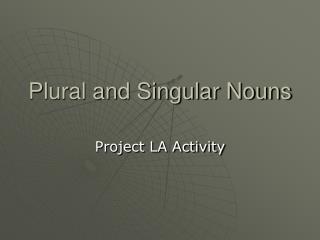
Plural and Singular Nouns
Plural and Singular Nouns. Project LA Activity. Plural Nouns. A plural form of a noun names more than one. It usually ends with s or es . Write P if the noun below is plural. Write S if the noun below is singular. houses baby church tables books bus.
656 views • 16 slides

Plural and Singular Nouns. Project LA Activity Adapted by Mrs. Mennell Grade 2 Open Court Unit 4 Lesson 4 (replaces workbook lesson). Nouns. A singular form of a noun names just one. . A plural form of a noun names more than one. It usually ends with s or es .
353 views • 12 slides

Plural and Singular Nouns. Project LA Activity. Plural Nouns. A plural form of a noun names more than one. It usually ends with s or es . Add es to make nouns plural that end with:. s buses x taxes ch benches sh dishes.
220 views • 14 slides
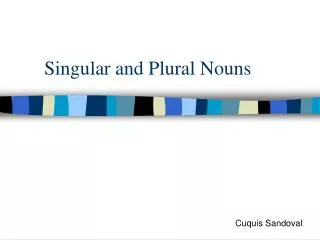
Singular and Plural Nouns. Cuquis Sandoval. There are 6 ways to change a noun from singular to plural. A noun is a person, place, or thing. Singular means only one noun. Plural means more than one noun. Rule 1 Most nouns become plural by adding “ s ”. boy. boy s. book. book s. desk.
469 views • 13 slides

Singular and Plural Nouns. Second Grade Grammar. Singular Nouns. Singular nouns name one person, place, thing, or animal. dog bench girl cat kite boy house park glass
494 views • 4 slides

Singular and Plural Nouns. Singular Nouns. Singular means ONE . Plural Nouns. Plural means MANY . Rule #1. To change the singular form of a word to it’s plural form, we usually add a “ s ” to the end of the word. Examples girl girls tortoise tortoises camera cameras
568 views • 14 slides

Singular and Plural Nouns. El (masculine, singular) - los (masculine, plural) La (feminine, singular) - las (feminine, plural) To make a noun plural, we generally add : -s to words ending in a vowel: el libro los libros
480 views • 1 slides

Plural and Singular Nouns. Project LA Activity. Plural Nouns. A plural form of a noun names more than one. It usually ends with s or es . Write P if the noun below is plural. Write S if the noun below is singular. houses baby church tables books bus. ANSWERS.
412 views • 17 slides

Plural and Singular Nouns. Project LA Activity. WITH ADDED SLIDES BY WBR Schools. Look at the singular and plural nouns below. How are they different?. A plural form of a noun names more than one. It usually ends with s or es .
516 views • 18 slides

Singular and Plural Nouns. Which Kind of Noun?. beach plates restaurant g irl bowling alley cake a pples mother cashier s igns cousin downtown. Nouns. Singular one one, a Ending not changed Plural more than one
518 views • 6 slides

SINGULAR AND PLURAL NOUNS
SINGULAR AND PLURAL NOUNS. THEME 3 - LESSON 12. What is a singular noun?. A singular noun is a word that names one person, place, thing, or idea. For example : snake letter girl. Find the singular noun or nouns in the following sentences. The dog ran down the street.
19.21k views • 12 slides

Singular and Plural Nouns. By Miss Chan Shuk Ming. Singular and Plural Nouns. Nouns with “s”, “ sh ”, “ ch ”, “x” endings. Nouns with “y” endings. Things are plural in English. scissor s glasse s trouser s jean s short s pajama s. Some plurals do not end in “–s”.
2.06k views • 8 slides

Singular and Plural Nouns. Rules to know. Ends in x; add –es Ends in vowel ; -es A,E,I,O,U Ends in –y; drop -y add –ies Ends in –f; drop –f add –ves Ends in –ss; add -es. Pastry. Pastries. Examples. Tomato. Tomatoes. Example. Country . Countries. Example. Writing Assignment.
291 views • 6 slides

Singular and Plural Nouns. By: Mrs. S. Irizarry. A noun that names one person, place, thing, or idea is a singular noun . A noun that names more than one person, place, thing, or idea is a plural noun . In most cases, you can change a singular noun to plural by adding –s.
368 views • 7 slides

Plural and Singular Nouns. Project LA Activity. Plural Nouns. A plural form of a noun names more than one. It usually ends with s or es. Write P if the noun below is plural. Write S if the noun below is singular. houses baby church tables books bus. ANSWERS.
312 views • 17 slides

Singular and Plural Nouns. Singular Noun: A noun that names one person, place or thing. Plural Noun: A noun that names more than one person, place or thing. Singular and Plural Nouns. Rules for adding -S. Rules for adding -es. Add –s to most singular nouns One boy> two boy s
1.27k views • 11 slides

Plural and Singular Nouns. Plural Nouns. A plural form of a noun names more than one. It usually ends with s or es. Write P if the noun below is plural. Write S if the noun below is singular. houses baby church tables books bus. ANSWERS.
359 views • 16 slides

Singular and Plural Nouns. Rule Add –s to make most nouns plural. Examples girl girls tortoise tortoises camera cameras monkey monkeys. Rule Add –es to nouns ending in s, z, ch, and sh. Examples walrus walruses moss mosses bush bushes beach beaches fox foxes
681 views • 7 slides

Plural and Singular Nouns. 2nd Grade. Plural Nouns. A plural form of a noun names more than one. It usually ends with s or es. Write P if the noun below is plural. Write S if the noun below is singular. houses baby church tables books bus. ANSWERS.
310 views • 12 slides

Plural and Singular Nouns
Plural and Singular Nouns . Plural Nouns . A plural form of a noun names more than one. It usually ends with s or es. Flowers. Cherries. Potatoes. Add es to make nouns plural that end with s, x, sh and ch. Bus es. Bu s. Bo x. Box es. Toothbrush es. Toothbru sh. Bench es.
361 views • 9 slides

- Join our Team
- Online Platform Tutorial
- TEFL Courses
- Contact Us / FAQ
Forgot Username or Password
- Active vs. Passive Voice
- Adverbial Clauses
- Adverbial Phrases
- Be Going To Statements
- Be Going To Wh Questions
- Be Going To Yes/No Questions
- Be Going To & Present Continuous
- Comparatives
- Superlatives
- Comparatives & Superlatives
- Zero Conditional
- First Conditional
- Second Conditional
- Third Conditional
- Mixed Conditionals
- Future Continuous
- Future Continuous vs. Future Perfect
- Future Perfect Continuous
- Future Perfect Simple
- Future Simple
- Future Tenses
- Future Time Clauses
- Gerunds & Infinitives
- Have Got & Has Got
- I wish & If only
- Imperatives
- Irregular Verbs
- Narrative Tenses
- Noun Clauses
- Noun Phrases
- Passive Voice
- Past Continuous
- Past Perfect
- Past Perfect Continuous
- Past Perfect Simple & Continuous
- Past Simple Affirmative & Negative
- Past Simple Passive
- Past Simple Regular Verbs
- Past Simple Was and Were
- Past Simple Wh Questions
- Past Simple Yes/No Questions
- Past Simple vs. Past Continuous
- Past Simple vs. Present Perfect
- Past Tense Review
- Present Continuous
- Present Perfect
- Present Perfect Continuous
- Present Perfect - Ever and Never
- Present Perfect - For and Since
- Present Perfect - Just, Yet & Already
- Present Simple Affirmative & Negative
- Present Simple Passive
- Present Simple vs. Present Continuous
- Present Simple vs. Present Perfect
- Present Simple Wh Questions
- Present Simple Yes/No Questions
- Present Tense Review
- Question Words
- Relative Clauses
- Reported Speech
- Subject-Verb Agreement
- Tag Questions
- There is & There are
- Wh Questions
- Abstract Nouns
- Adjective-Noun Collocations
- Adjectives of Feeling & Emotion
- Adjectives of Opinion
- Adjectives of Quantity
- Adjective Opposites
- Adjective Order
- Adjective-Preposition Collocations
- -ed and -ing Adjectives
- Adverb-Adjective Collocations
- Adverb Order
- Adverbs of Affirmation & Negation
- Adverbs of Degree
- Adverbs of Frequency
- Adverbs of Manner
- Adverbs of Place
- Adverbs of Time
- Articles - a, an, the
- Causative Verbs
- Collective Nouns
- Common & Proper Nouns
- Compound Adjectives
- Compound Nouns
- Concrete Nouns
- Conjunctions
- Countable & Uncountable Nouns
- Demonstrative Adjectives
- Demonstrative Pronouns
- Dependent Prepositions
- Indefinite Pronouns
- Intensifiers & Mitigators
- Interjections
- Modal Verbs of Ability
- Modals of Deduction & Speculation
- Modals of Necessity
- Modals of Obligation & Prohibition
- Modals of Possibility & Certainty
- Onomatopoeia
- Parts of Speech
- Phrasal Verbs
- Possessives
- Prepositions of Movement
- Prepositions of Place
- Prepositions of Time
- Proper Adjectives
- Quantifiers
- Reflexive Pronouns
- Sense Verbs and Adjectives
- Singular & Plural Nouns
- So and Such
- Subject & Object Pronouns
- Too and Enough
- Transition Words
- Verb-Noun Collocations
- Agreeing & Disagreeing
- Asking Permission
- At the Dentist's
- At the Doctor's
- Being Polite
- Classroom Language
- Complaining & Apologizing
- Complimenting
- Critical Thinking & Problem Solving
- Describing Character & Personality
- Describing People's Appearance
- Describing Places
- Describing Things
- Etiquette and Manners
- Getting Around
- Getting to Know You
- Giving Advice
- Giving Directions
- Giving Opinions
- Giving Personal Information
- Greetings & Introductions
- Indirect Questions
- Likes and Dislikes
- Making Arrangements
- Making Decisions
- Making Excuses
- Making Invitations
- Making Offers & Promises
- Making Requests
- Making Suggestions
- Online Communication
- Ordering Food & Drink
- Social Media
- Telephoning
- Times and Dates
- British English vs. American English
- Cities, Towns & Places
- Clothes & Fashion
- Computers & Smartphones
- Countries & Nationalities
- Crime, Law & Punishment
- Cultural Celebrations
- Daily Routines
- Everyday Obects
- Family & Relationships
- Food & Drink
- Going Out & Entertainment
- Health & Fitness
- Hobbies & Free Time
- Houses, Rooms & Furniture
- Jobs & the Workplace
- Love, Romance & Dating
- Modes of Transport
- Parts of the Body
- Reading Comprehension
- Shapes & Measurements
- The Natural World
- Time Expressions
- TV & Film
- Valentine's Day
- Academic Collocations
- Academic Phrasal Verbs
- Academic Reading Comprehension
- AWL Sublist 1 & 2
- Cause and Effect Essays
- Compare and Contrast Essays
- Discussion Essays
- Discussions Practice
- Discussion Skills
- Essay Writing
- Paragraph Writing
- Persuasive Essays
- Presentation Skills
- Problem Solution Essays
- Punctuation
- Reading Skills
- Referenced Essays
- Study Skills
- The Writing Process
- Business Collocations
- Business Emails
- Business Idioms
- Business Meetings
- Business Negotiations
- Business Phrasal Verbs
- Closing a Presentation
- Describing Graphs & Charts
- Presentation Language & Structure
- Resumes, CVs & Email Cover Letters
- Starting a Presentation
- Talking About Jobs
- Answer Games
- Brainstorming Games
- Category Games
- Classic Childhood Games
- Counting Games
- Describing Games
- Drawing Games
- Drilling Activity Games
- First Day of Class Games
- Flashcard Games
- Grammar Games
- Hangman Games
- Listening Games
- Miming Games
- Music Games
- Question & Answer Games
- Sentence Race Games
- Spelling Games
- TV Game Shows
- Vocabulary Games
- Word Association Games
- Yes/No Question Games
- Classroom Interaction Patterns
- Classroom Management
- Concept Checking
- Cultural Awareness
- Developing Students' Listening Skills
- Developing Students' Reading Skills
- Developing Students' Speaking Skills
- Eliciting Techniques
- ESL Dictations
- How to Introduce a Lesson
- How to Use Music in ESL Class
- Lesson Planning
- Making Teaching Materials Relevant
- Problems Learning English
- Teaching English Idioms
- Teaching English Vocabulary
- Teaching Large Classes
- Teaching Mixed-Ability Classes
- Teaching Small Classes
- The First Day of Class
- Using Correction in Class
- Using Song Gap Fills
- Online Membership
- ESL Essentials eBook Series
Singular and Plural Nouns ESL Games, Activities and Worksheets
- Elementary ( A1-A2 )
- Pre-intermediate ( A2 )
- Upper-intermediate ( B2 )

Make it Plural
Esl singular and plural nouns game - grammar: matching, spelling - group work - elementary (a1-a2) - 20 minutes.
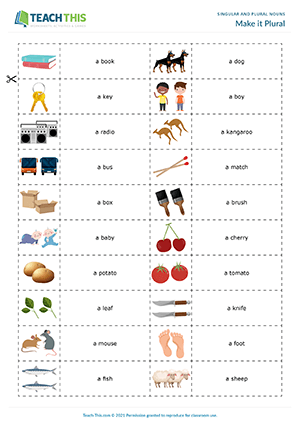
Singular to Plural Crossword
Esl singular and plural nouns crossword - vocabulary activity: crossword, changing word forms, spelling - elementary (a1-a2) - 20 minutes.
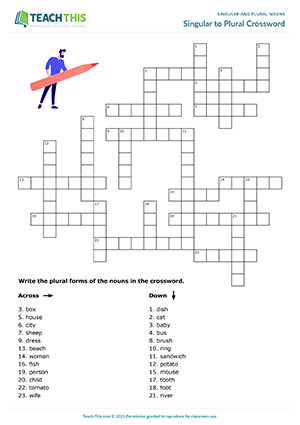
Singular or Plural?
Esl singular and plural nouns worksheet - grammar and vocabulary exercises: gap-fill, categorizing, multiple choice, error correction - elementary (a1-a2) - 30 minutes.
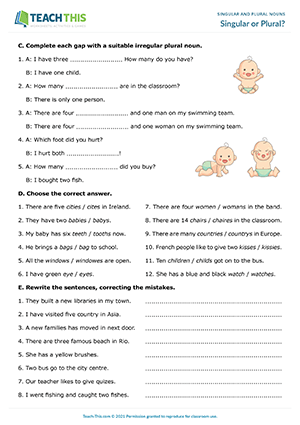
What do you see?
Esl singular and plural nouns board game - grammar: spelling, forming sentences - group work - elementary (a1-a2) - 25 minutes.
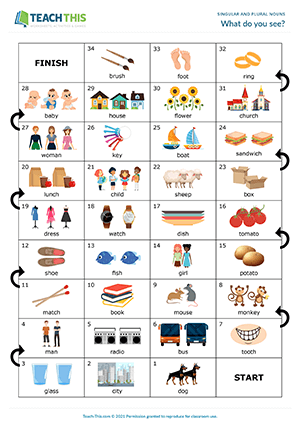
Perplexing Plurals
Esl singular and plural nouns activity - vocabulary and grammar: gap-fill, spelling, guessing - pair work - pre-intermediate (a2) - 25 minutes.
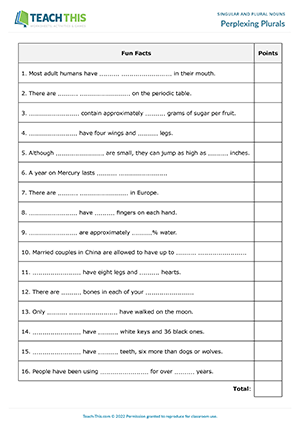
Singular and Plural Nouns Practice
Esl singular and plural nouns worksheet - grammar exercises: matching, changing word forms, identifying, error correction, gap-fill - pre-intermediate (a2) - 25 minutes.
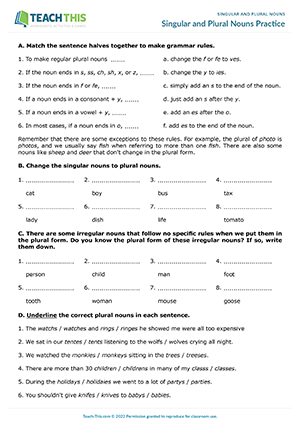
Singular to Plural
Esl singular to plural game - vocabulary and grammar: matching, forming sentences from prompts, freer practice - group work - pre-intermediate (a2) - 25 minutes.
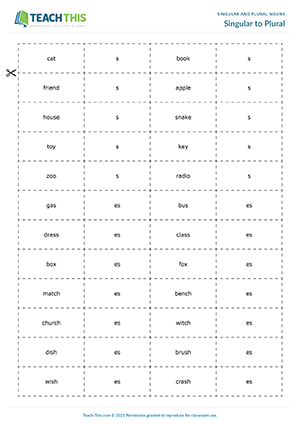
Singular vs. Plural
Esl singular and plural nouns board game - vocabulary: changing word forms, spelling - group work - upper-intermediate (b2) - 30 minutes.
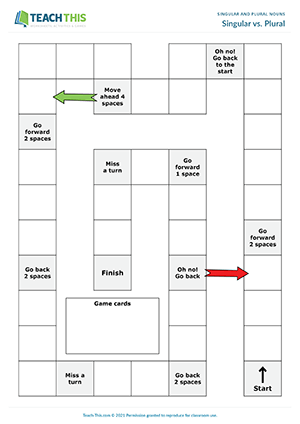
New Teaching Resources eBooks
Now Available!
Get Started Here
https://www.teach-this.com/esl-essentials
LATEST FREE RESOURCES
- Everyday Objects
Elementary (A1-A2)
Upper-intermediate (B2)
LATEST MEMBER RESOURCES
Food and drink.
Intermediate (B1)
Discussions

- Have got & Has got
- Adverbs of Affirmation and Negation
- Concrete nouns
- Sense Verbs & Adjectives
- AWL Sublist 1 and 2
- Talking about Jobs
- TEFL Certification & Courses
- Privacy Policy
- Terms of Use

- All topics A-Z
- Grammar
- Vocabulary
- Speaking
- Reading
- Listening
- Writing
- Pronunciation
- Virtual Classroom
- Worksheets by season
- 600 Creative Writing Prompts
- Warmers, fillers & ice-breakers
- Coloring pages to print
- Flashcards
- Classroom management worksheets
- Emergency worksheets
- Revision worksheets
- Resources we recommend
IMAGES
VIDEO
COMMENTS
Grammar - plural nouns. This powr point presentation consists of some slides and shows the learners how to make plural nouns. Hope it will be useful for you and your students. Have a nice teaching! 84 uses. Vicusvic.
Download this nouns PowerPoint and use it in class today! This PPT is great for teaching singular and plural nouns to kids and beginner English language learners. Students will learn what a noun is, the difference between proper and common nouns, and the plural noun rules. See below to preview and download this PPT.
151 Plural English ESL powerpoints. SORT BY. Most popular ... There are two sheets. 705 uses. butterfly05. plurals. this is a presentati. 579 uses. Herber. PLURALS PPT. This is a Powerpoint. 12550 uses. estrelapolar. IRREGULAR PLURALS ... 4445 uses. Kelz1. Irregular Plurals. This PowerPoint has . 3206 uses. indira. Plural Forms. A grammar guide ...
1/10. Let's do English ESL grammar guide. This is a Powerpoint presentation on plural of nouns. It contains the irregular forms and a multiple choice game.
Table of Contents. How To Teach Plural Nouns. Step 1: Introduce Plural Nouns In Context. Step 2: Introduce The Plural Noun Rules. Step 3: Practice Forming Plural Nouns. Step 4: Play A Plural Nouns Game. Step 5: Introduce Irregular Plural Nouns. Step 6: Make Sentences With Plural Nouns. Related Resources.
Singular and plural nouns ppt. 1. The document outlines three rules for making nouns plural in English: add -s to most nouns, add -es to nouns ending in s, z, ch, x, tch, o, ss, and sh, and change y to i and add -es when a noun ends in a consonant and y. 2. Examples are provided to illustrate each rule, such as girls, tortoises, cameras, and ...
The document provides rules for making nouns plural in English. It states that most nouns form the plural by adding -s, while some nouns ending in certain letters like -s, -sh, -ch, -x, or -o add -es instead. Some nouns ending in consonant-y or -f/-fe change the ending to -ies or -ves.
and add -es Child, tooth, mouse Some nouns have irregular plurals. There's no trick, just memorize them. lad ies Children, teeth, mice 6 Now you turn. In the worksheet, circle the singular nouns in each sentence. Underline the plural nouns in each sentence. If you forget what to look for check the key in the box.
Use this PowerPoint to introduce your ESL students to the grammar rules of regular plural nouns (adding 's' or 'es'). This lesson has plenty of ESL games and ESL activities to support teaching regular plural nouns in a fun way to young learners. It is suitable for students who are beginner level (CEFR A1). The above video may be from a third ...
To make regular nouns plural, add ‑s to the end. example: birthday- birthdays. example: berry- berries. If the singular noun ends in -y and the letter before the -y is a vowel, simply add an -s to make it plural. If a singular noun ends in ‑y and the letter before the -y is a consonant, change the ending to ‑ies to make the noun plural.
Plural of Nouns PowerPoint Presentation. Found a mistake? This is fully animated PowerPoint presentation for teaching or revising plural of nouns at elementary level. There are simple and easy explanations and examples illustrated with graphics for easy memorization.
Things Around the House. The presentation provides some explanation about parts of the house, things around the house, the use of singular and plural noun, and some exercises for students. 121 uses. A selection of English ESL singular and plural nouns ppt slides.
Powerpoint: Plural Nouns. Resources. A powerpoint on plural nouns ready to be used with animations and transitions for a lesson. Introduce to students the basic spelling concepts of plurals. Powerpoint: Plural Nouns Download. Use the powerpoint to introduce the concept of singular and plural. Teach students how to write in basic plural form.
Create two baskets or containers labeled "Singular" and "Plural.". Prepare a collection of noun cards, each with a singular or plural noun written on it. Students take turns selecting a card and deciding whether it is a singular or plural noun. They must then toss the card into the corresponding basket.
English Nouns. A noun is a word that names a person, place, thing, or idea. Prototypical English nouns show number through singular and plural forms. Singular nouns reference one person, place, thing, or idea while plural nouns reference two or more people, places, things, or ideas. Regular nouns in English take either the suffix -s or the ...
Presentation Transcript. Singular and Plural Nouns Notes On Generalizations For Spelling/Forming Plural Nouns. Singular vs. Plural • A singular noun names one person, place, thing, or idea. • One cat, one store, one item • A plural noun names two or more persons, places, things, or ideas. • Two cats, four stores, fifteen items.
Articles and Plurals. In this power point presentation students will learn about the use of articles and plurals. There are some simple explanations followed by exercises and online activities. 279 uses. A selection of English ESL plural nouns: irregular plurals ppt slides.
Please let us know if the video is no longer working. Making Nouns Plural with s es and ies PowerPoint contains: ies Loop Cards [PDF] Twinkl ESL Resources Young Learners (3-12) Grammar Topics A-Z Singular and Plural Nouns. In this ESL lesson pack, the teaching PowerPoint explains how to make nouns plural using -s, -es and -ies.
Make it Plural. ESL Singular and Plural Nouns Game - Grammar: Matching, Spelling - Group Work - Elementary (A1-A2) - 20 minutes. In this enjoyable singular and plural nouns game, students make singular nouns plural and spell the plural forms. Players take it in turns to turn over one word card and one picture card.
It's based on Murphy's Basic Grammar and presents the topic PLURAL NOUNS (Flower (s) /Bus (es). The goal was to show the rule and complete one exercise from the book. Power Point Presentation I designed to use during my Skype lessons.
Learning how to make nouns plural is an important part of Literacy, but plurals aren't always easy for young learners to figure out. So, why not give them a little help with an engaging activity the whole class can take part in? This colourful PowerPoint is an ideal resource for helping your students to make nouns plural using the endings '-s', '-es' and '-ies'. It gives a really ...
Singular and Plural Nouns. zeynepyilmaz. 10563. 80. 23. 0. 1/5. Let's do English ESL grammar guide. -- teaching your students singular and plural nouns with exercises -- -- teaching your students singula….
A selection of English ESL nouns ppt slides. Log in / Register. Worksheets. Powerpoints. Video Lessons ... Clear all filters. English ESL Powerpoints. Grammar Topics. Nouns. 516 Nouns English ESL powerpoints. SORT BY. Most popular. TIME PERIOD. All-time. Herber. GET DRESSED! CLOTHES. ... Singular and Plural . Hand out about plura. 12915 uses ...